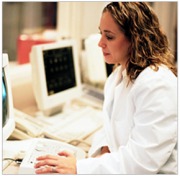Medical Transcription – The Procedure
Step 1 – Transfer of Dictation - The physician sends his dictations (using toll-free number or digital dictation machine) to the company providing the transcription services. Whichever method is used, the dictation files reach the company’s secure servers. Olympus digital recorders, with superior sound and recording quality, are quite popular with physicians.
Step 2 – Accessing the Dictations - The dictations are downloaded by the service provider from its central server and assigned to the medical transcription team. Each file is provided a separate job ID to enable easy identification.
Step 3 – Transcription - Transcriptionists use a computer, headphones, foot pedals, and word processing package to perform their job. The transcription listens to the dictation using the headphones. The dictations are transcribed into text format using word processing software such as Microsoft Word. Foot pedals enable playing and replaying of dictations for checking and making corrections if required. To transcribe digital dictations, the headphones are connected to the computer’s speakers or sound card, while the foot pedal is plugged into the PC’s serial port.
In the course of transcription, the transcriptionist may have to make use of several references and online resources to check up on terminology, drug names, spelling and other information pertaining. This includes:
• Stedman’s Electronic Medical Dictionary
• Spell checker applications
• Medical specialty books
• American Drug Index
• Thesaurus
• Style Guide
• Medical publications, newsletters and journals
Various sound/media players and converters are also used to improve pitch and speed for better clarity, making transcription easier.
Step 4 – Quality Checks – The transcripts are checked for accuracy in spelling, information, formatting, standardization, and other factors. Care is taken to achieve an accuracy level of 98 percent and above.
Step 5 – Transfer of Transcription – Depending on the physician/healthcare practice’s preference, the transcripts are delivered by FTP or a secure (minimum 128 bit encryption) browser.
Step 6 – Downloading of Transcripts – The healthcare practice/physician can retrieve the completed transcripts from the account they have with the service provider.
Professional Medical Transcription Services ensure HIPAA Compliance
A professional medical transcription service provider would ensure medical transcription in compliance with HIPAA (Health Insurance Portability and Accountability Act) stipulations. All employees and infrastructure are made to adhere to the necessary security regulations, so no sensitive patient information leaves the company’s premises or falls into unauthorized hands.




 RSS Feed
RSS Feed